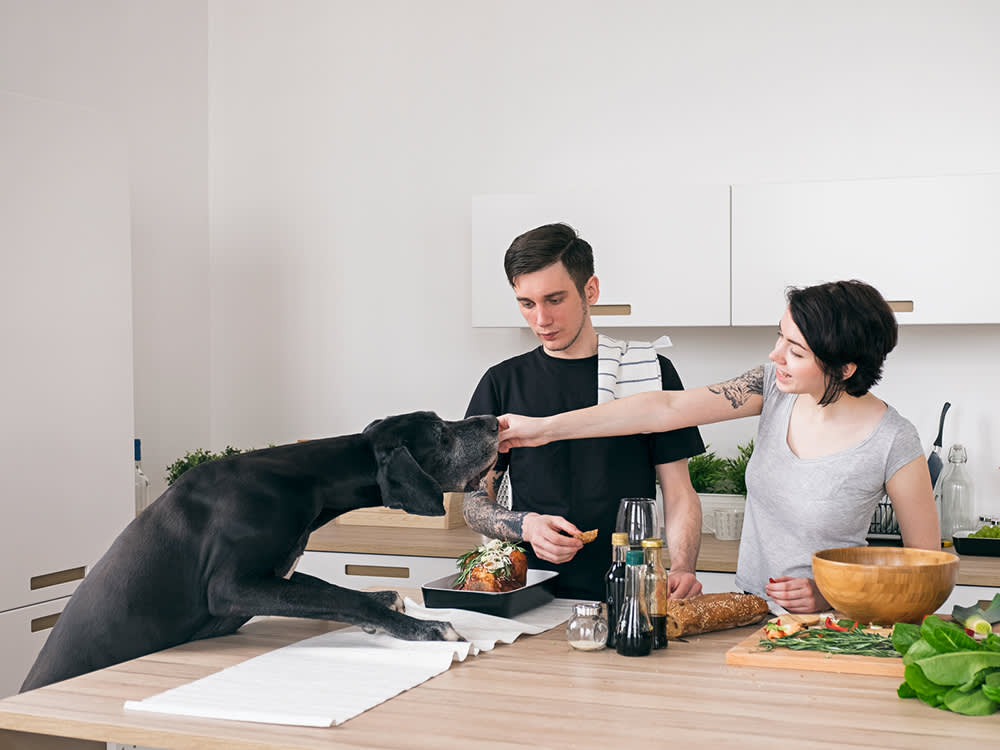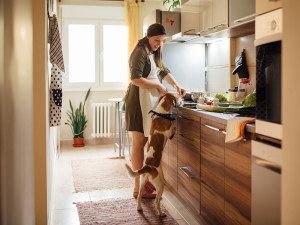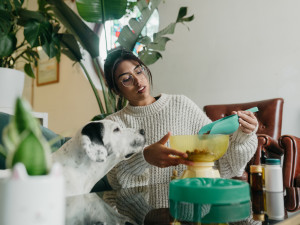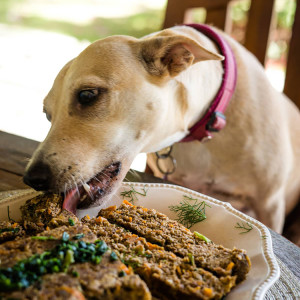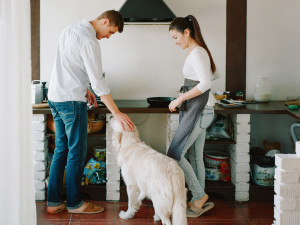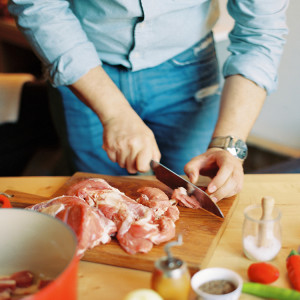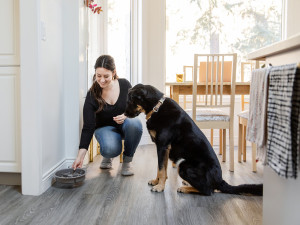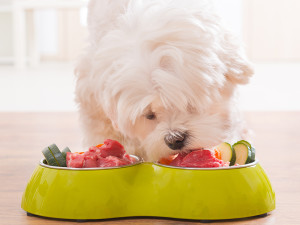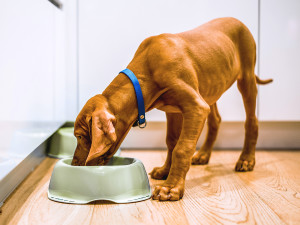Is Cooking Your Dog’s Food Worth it?
A nutritionist on dogs’ unique dietary needs, important ingredients, and other pro tips for home-cooked dog food.
You’d probably shell out for dog-friendly sushi if you thought it would please your pup’s taste buds. So of course you would spend hours in the kitchen making a home-cooked meal for them. But is it really worth your time and energy?
Cooking for your dog can have many benefits, including fewer preservatives and additives in their diet, more varied and potentially higher quality ingredients, and, of course, the ability to tweak the recipe based on your pup’s particular tastes. Homemade meals may even make it possible to feed your dog well for less. Even when you add the cost of a vitamin/mineral supplement and calcium, it can still cost less than commercial food (like, as little as $3 a day). But there’s a catch: What you save in money, you spend in time and commitment.
Dogs’ Unique Dietary Needs
It helps to understand a bit about the history of dog diets first. As both capable hunters and scavengers, dogs ate from a diverse menu when they began accompanying humans. An omnivorous diet of protein, carbohydrate and fat sources is most healthy for them; pups in good health can handle the fat in their diet more effectively than humans can — their bodies use it for energy and then efficiently clear it from the bloodstream.
The caveats? Dogs have different nutrient requirements than people. For example, they need high-quality protein, more calcium and more minerals for their proportional body size. Calcium is particularly critical. In The Complete Holistic Dog Book, co-author Dr. Katy Sommers, notes that “calcium is perhaps the single most important supplement for a successful home-cooked diet. Even if you’re feeding a variety of foods, you’ll need to supply an extra source of calcium.” (She also points out that, if you’re mixing homemade and commercial foods, you don’t need to supplement as heavily, as commercial foods contain adequate or possibly even excessive amounts of calcium and phosphorus.)
What to Watch Out for When Cooking for Dogs
As much as pups might beg for their humans’ snacks, there are some foods that dogs should never be given, including macadamia nuts, chocolate, tea, coffee, raisins, grapes, onions, or excessive amounts of garlic. And, of course, check with your veterinarian before making big changes to your dog’s diet, particularly if they have any preexisting health conditions. Once you get the green light, make the changes gradually to avoid digestive upsets; introduce new foods slowly, substituting a small proportion of the new food for the old over time. Finally, be careful not to provide too many overall calories (energy), as obesity is just as unhealthy for dogs as it is for humans; your vet can help you determine how much your dog should be eating.
Food safety is also an issue: While dogs have many defenses against bacteria, parasites and other food-borne pathogens, they are not immune to them. Be sure to keep utensils clean, perishables refrigerated and ingredients cooked to appropriate internal temperatures to kill off any unwanted bugs. This is particularly important for puppies, old dogs or those with a health condition that makes them vulnerable to food-borne illness.
Important Ingredients in Your Dog’s Diet
In general, homemade recipes should contain a high-value protein source (muscle meat such as liver, eggs, fish, liver), a fat source (safflower, olive, canola or fish oil such as salmon and cod), a fiber-containing carbohydrate (brown rice, sweet potato, oats, barley), and a phytochemical source (fruits, vegetables, herbs). Substitutions can be made: for example, if you know your dog likes whole-grain pasta, substitute pasta for barley as a carbohydrate source. Some dogs, (much like some kids we know), hate veggies but will eat fruit, so use fruit instead.
Yogurt, cottage cheese, beans and tofu can occasionally be used as protein sources, but keep in mind that not all dogs can tolerate dairy products; beans or soy may turn them into a tooting machine or cause them to experience other gastrointestinal “issues.” Test your dog’s tolerance with small quantities before serving them a whole meal.
Generally, a healthy, adult, medium-sized dog (approximately 35 to 40 pounds) who’s moderately active requires approximately 1,800 mg of calcium daily, according to Dr. Sommers. If your dog is smaller or larger, their total calcium requirements can be calculated using 600 mg for every 12.5 pounds. (If your dog is a senior, still growing or has health issues, please consult your veterinarian — we really can’t say this often enough!)
How to Store Homemade Dog Food
Making dog food in quantity requires a food-storage strategy. After you cook a batch of food, let it cool, and — if you make more than your dog can eat within a couple of days — portion it into reusable, washable containers, then freeze and defrost as needed. You can safely keep cooked food in the refrigerator for three days; after that, spoilage is a concern so it should be frozen. The most convenient way to do this is to parcel it into multi- or meal-size containers. Both glass and plastic work for these needs, but do be sure to choose BPA-free plastic.
Btw, our editors (and their pets) picked out these products. They’re always in stock at the time we publish, but there’s a chance they’ll sell out. If you do buy through our links, we may earn a commission. (We’ve got a lot of toys to buy over here, you know?)
Jars
Weck Glass Jarsopens in new tab are beautifully designed, wide-mouth jars that have many great uses, including for preserving dog food. But they can also be used for freezing items like leftover chicken stock. Their wide opening makes scooping the food in and out of the jar that much easier. When using the jars in a freezer, you should use the plastic lids (purchased separatelyopens in new tab) rather than the glass ones.
Vacuum Sealer
You might want to store the food using the FoodSaveropens in new tab FM2000 Vacuum Sealeropens in new tab if freezer space is at a premium in your kitchen. This vacuum sealer is simple and reliable and actually fun to use.
Freezer containers
Cubeware 15-Pack Snap-Seal Bento Boxesopens in new tab, a take-off on traditional Japanese single-portion home-packed/take-out containers, hold 28 ounces of food. (If your prefer to store a week’s worth of food in one container, look for a large size.) As an added benefit, they can be easily stacked on a refrigerator shelf or in the freezer. They are also microwavable so you can "zap" them for a few seconds to bring the meal to room temperature, something that makes the food tastier to your dog. Also remember not to feed your dog from these containers, always best to use ceramic or stainless bowls for feeding your dog.
Tools of the Trade
If you're making a lot of dog food, you'll need the right tools:
Electric Pressure Cooker
Truly an invaluable kitchen appliance for everyday use. It can make oh-so-many recipes, including stock and bone broth, quickly and easily.
Slow Cooker
For making slow-cooker meals or use the “low” cooking function for light cooking the vegetables and grains before blending them with the meat protein.
All Clad Slow Cookeropens in new tab 7 Qt Gourmet Slow Cooker with All-in-One Browningopens in new tab
Sous Vide
Using a sous videopens in new tab to prep the meat for dog food, both poultry and red meat, results in far less shrinkage. Cooking a chicken breast in a pressure cooker on a low pressure setting can decrease its weight by around 32 percent; in slow cooker, it decreases by 24 percent; but in a sous vide, it only loses 10 percent (or less).
When a recipe requires 7 pounds of cooked chicken (such as this chicken & vegetable dog food recipe), depending on which method you use, you might have to purchase more than 12 pounds of chicken to wind up with that amount. More chicken means a higher cost per serving. The other benefit of sous vide cooking is that it requires much lower heat (albeit a longer cooking time) to cook food, so more of the vitamins and nutrients are retained.
Silicone Sous Vide Bags:
One of the environmental drawbacks to the sous vide method is that you cook the food inside a air-tight plastic bag immersed in water (“sous vide” means “under vacuum”), and you can go through a lot of bags in the process. Better to use reusable bags, like silicone versions, including these from Stasheropens in new tab too.
Final Considerations for Home-Cooked Dog Food
Many veterinarians, while acknowledging that pet food recalls and the poor quality of some pet foods are causes for concern, still feel that homemade diets, when fed exclusively, may result in nutritional imbalances and vitamin/mineral deficiencies that may pose threats to your dog’s health. Therefore, if you choose to feed your dog a homemade diet, it is important that you understand and provide what your dog needs to stay healthy; veterinary nutritionists can assist in developing suitable homemade diets.
While caution was taken to give safe recommendations and accurate instructions in this article, it is impossible to predict an individual dog’s reaction to any food or ingredient. Readers should consult their vets and use personal judgment when applying this information to their own dogs’ diets.
* The cost of feeding homemade will vary according to the size, activity level and health of your dog. Dogs who are pregnant or lactating, growing pups, and those who participate in endurance activities require much more nutrition (calories, protein, fatty acids) and have other special nutritional needs.
Disclaimer alert: This article is here to share information. But, much like pineapple on pizza, the topic may be controversial. Meaning, not all vets or pet professionals agree. Because every pet is a unique weirdo with specific needs. So, don’t take this as fact or medical advice. Talk things over with your vet when making decisions, and use your best judgment (about both your pet’s health and pizza toppings).
